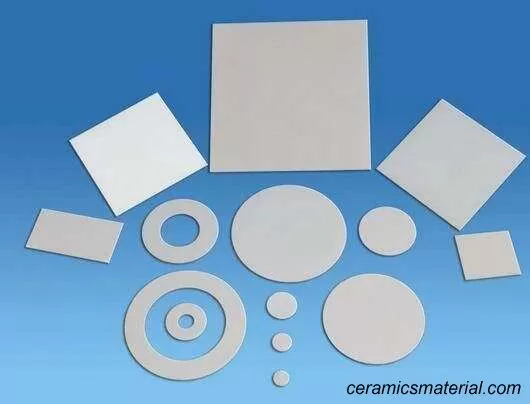Application and introduction of nitride insulating ceramics
1. Aluminum nitride insulating ceramics
Y2O3, CaO and other additives are usually added during the manufacturing process of aluminum nitride ceramics. Aluminum nitride materials containing CaO can achieve lower temperature sintering, and their thermal conductivity is about 100W/(m·K). For polycrystalline aluminum nitride ceramics, optimizing their microstructure is a key step in the production process. After heat treatment in a non-oxidizing atmosphere, the thermal conductivity of pressureless sintered aluminum nitride materials containing calcium oxide can be increased to 219W/(m·K). Adding Y2O3 can further improve its thermal conductivity, heat resistance and mechanical strength.
Metallization of ceramics is a common problem when used as packaging or substrate materials. Although aluminum nitride and tungsten have a good match in thermal expansion coefficient, they lack chemical reaction and it is difficult to form an ideal bond. The metallization performance can be improved by adding flux substances such as CaO to tungsten powder. These fluxes can react with Al2O3 on the surface of aluminum nitride to form aluminates and migrate at the AIN grain boundary, thereby enhancing the bonding between AIN and tungsten powder.

Aluminum nitride ceramics are used in integrated circuit substrates to help improve the integration of integrated circuits.
2. Boron nitride (BN) insulating ceramics
Boron nitride (BN) is known for its excellent thermal conductivity, among which the theoretical thermal conductivity of cubic BN single crystal is as high as 1300W/(m·K). Both hexagonal (graphite type) and trigonal BN have layered structures.
Hexagonal BN not only has good thermal conductivity and mechanical processing properties, but also has high-frequency dielectric properties and non-toxicity. Its thermal conductivity changes little with temperature, making it one of the insulating ceramic materials with great development potential.
In order to improve the heat dissipation performance of integrated circuit substrates, on the one hand, people use beryllium oxide (BeO), which has a thermal conductivity 9 times higher than aluminum oxide but is toxic, as a substrate material for high-power integrated circuits; on the other hand, SiC is also used as a substrate. Adding BeO to SiC can impart grain boundary insulation, turning the SiC material into an insulator while improving its heat resistance and strength.
Share the Application and introduction of nitride insulating ceramics
Recent News
- Study on high-temperature hydrophobic modification and f...2024-08-19
- Research progress on thermal protection coatings on niob...2024-08-19
- Introduction and application of alumina insulating ceram...2024-08-08
- Introduction to the manufacturing process and applicatio...2024-03-05
- Introduction and application of 95 alumina precision cer...2024-02-28
- Introduction to the characteristics, processes, and appl...2024-02-28
- Introduction and application of alumina precision cerami...2024-01-22
- Diversified applications of precision ceramic materials:...2023-12-19
- Comparing precision ceramic cleavers, diamond knives, an...2023-12-16
- Advantages of precision ceramic dispensing valves compar...2023-12-07

